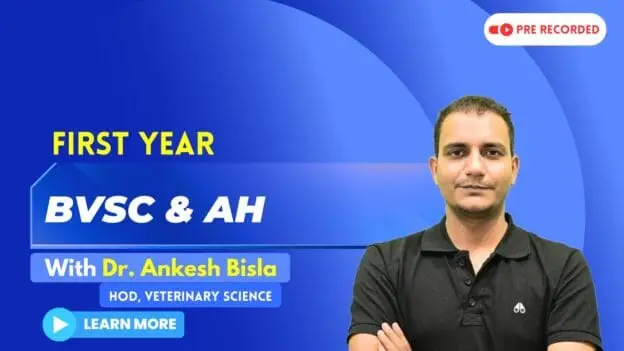
📖 Comprehensive Notes & E-Booklets
- Detailed, syllabus-aligned notes for all subjects.
- Easy-to-understand summaries, diagrams, and flowcharts.
🗂️ Structured Learning
- Organized by subjects, units, and chapters for clarity.
- Step-by-step progression for strong foundational knowledge.
🎯 Exam-Oriented Prep
- Tailored materials to ace exams with confidence.
- Includes sample papers, key points, and mnemonics.
🎥 Pre-Recorded Video Lectures
- Expert-led lectures with visuals for deeper understanding.
- Flexible learning at your own pace, anytime, anywhere.
✨ Why Choose This?
- Efficient: Saves time with focused material.
- Convenient: Accessible e-books & videos.
- Effective: Ensures exam readiness with ease!
Key subjects covered in the first year include:
- Veterinary Anatomy
- Veterinary Physiology
- Livestock Production and Management (LPM)
Start your BVSc & AH journey with these all-in-one resources! 🐾📘
Course Content
Crash Course
Lesson Content
0% Complete
0/3 Steps
Anatomy
9 Topics
Expand
VAN-111 - Veterinary Gross Anatomy –I (Osteology, Arthrology, and Biomechanics)
Lesson Content
0% Complete
0/6 Steps
Lesson Content
0% Complete
0/3 Steps
VPB –111- VETERINARY PHYSIOLOGY -I (Blood, Cardiovascular, Excretory system and Body Fluids)
Lesson Content
0% Complete
0/36 Steps
Lesson Content
0% Complete
0/20 Steps
Lesson Content
0% Complete
0/22 Steps
Lesson Content
0% Complete
0/10 Steps
VPB-121 VETERINARY PHYSIOLOGY -II (Neuromuscular, Digestive and Respiratory systems)
Lesson Content
0% Complete
0/10 Steps
Lesson Content
0% Complete
0/10 Steps
Lesson Content
0% Complete
0/18 Steps
Lesson Content
0% Complete
0/18 Steps
Lesson Content
0% Complete
0/19 Steps
Lesson Content
0% Complete
0/16 Steps
Lesson Content
0% Complete
0/13 Steps
VPB-221-VETERINARY PHYSIOLOGY - III (Endocrinology, Reproduction, Growth and Environmental Physiology)
Lesson Content
0% Complete
0/20 Steps
Lesson Content
0% Complete
0/12 Steps
Lesson Content
0% Complete
0/14 Steps
Lesson Content
0% Complete
0/6 Steps
Lesson Content
0% Complete
0/6 Steps
Lesson Content
0% Complete
0/11 Steps
LPM
Lesson Content
0% Complete
0/15 Steps
About Instructor
Wise IAS
33 Courses
Preview this Course


Login
Accessing this course requires a login. Please enter your credentials below!
